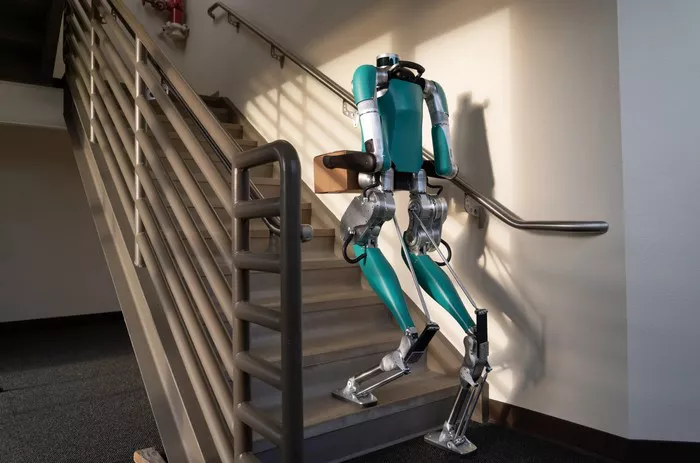Amazon is making headlines with its ambitious efforts to develop humanoid robots capable of delivering packages. Operating from a specialized San Francisco facility known as the “humanoid park,” the company is testing robots designed to navigate real-world obstacles—climbing stairs, crossing doorways, and handling packages in environments that mimic typical American neighborhoods.
Inside the “Humanoid Park” Testing Facility
The “humanoid park” is a highly controlled indoor environment created to simulate delivery challenges robots would encounter in daily operations. This includes mock doorways, staircases, and a Rivian electric delivery van parked to replicate last-mile logistics. The purpose of this testing ground is to assess how well robots manage the unpredictable settings common to residential deliveries.
Currently, Amazon is evaluating the Unitree G1 robot, developed by Chinese robotics firm Unitree Robotics. Priced around $16,000, the G1 features 23 joint motors and force-sensitive grippers, enabling it to climb stairs and carry packages. However, the robot remains in its early development phase, with ongoing assessments focused on its ability to perform fundamental delivery tasks safely and efficiently.
Learning from Past Attempts: The Scout Robot
Amazon’s journey into delivery robotics isn’t new. In 2019, the company introduced Scout, a six-wheeled sidewalk delivery robot. Despite initial promise, Scout faced operational challenges—such as freezing when encountering squirrels and difficulty recognizing porch steps—that led to its quiet discontinuation in 2022. Insights from Scout’s limitations are informing the design and strategy of the current humanoid robot program.
Two Robots, Two Strategies: Unitree G1 vs. Agility Robotics’ Digit
Amazon is pursuing a dual approach to robotics. Alongside testing the Unitree G1 for last-mile, customer-facing deliveries, the company is piloting Agility Robotics’ Digit robot within warehouses. Digit specializes in stable, repetitive tasks like tote recycling but is not designed for outdoor delivery. Both robots remain in trial stages, helping Amazon determine the best roles and environments for robotic automation.
AI: The Heart of Amazon’s Robotics Vision
A crucial component of Amazon’s robotics initiative is its investment in artificial intelligence. The newly formed Agentic AI group focuses on developing sophisticated AI systems to enable robots to perform complex, multistep tasks and understand natural language commands. These advancements are key to helping robots navigate dynamic environments and interact safely with people and objects.
Amazon envisions a future where humanoid robots work seamlessly with its Rivian electric delivery vans. Eventually, robots will exit vans to complete doorstep deliveries. For now, however, these capabilities are confined to pilot programs and controlled settings.
Robots as Workforce Partners, Not Replacements
Amazon emphasizes that these robots will supplement, not replace, human workers. The company is actively recruiting personnel for robot maintenance and monitoring roles. However, regulatory hurdles remain significant: only a handful of U.S. states currently permit autonomous sidewalk robots, and public acceptance of delivery robots varies widely.
Challenges and Competition in Delivery Robotics
Although promising, Amazon’s humanoid delivery robots are not yet ready for widespread deployment. The project forms part of Amazon’s broader automation strategy to enhance delivery speed and logistics efficiency, but technical and regulatory obstacles persist.
Competitors are also innovating rapidly. Tesla’s Optimus robot is already handling material transport in Gigafactories, Boston Dynamics’ Spot can navigate complex terrain and open doors (though not designed for delivery), and ANYmal’s quadruped robots autonomously traverse stairs and doorsteps. Experts suggest that wheeled or quadruped robots might offer greater reliability and cost advantages over humanoid forms.
Looking Ahead: A Step Toward the Future of Delivery
Amazon’s humanoid delivery robot program represents a forward-thinking leap in robotics and logistics technology. Though still experimental, the ongoing testing in the “humanoid park” and Amazon’s strong commitment to advanced AI and robotics development highlight its potential to reshape last-mile delivery in the years to come.
Related topics:

